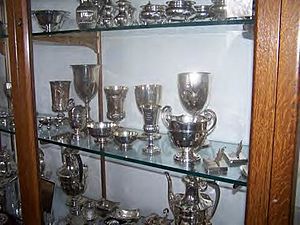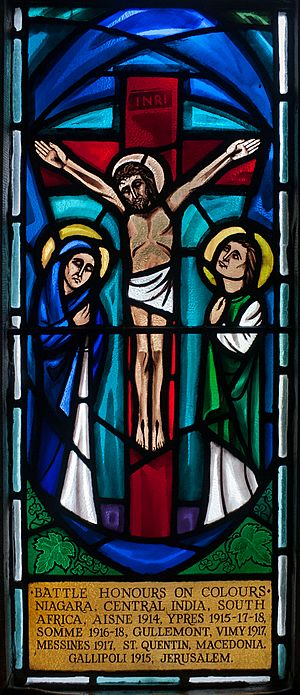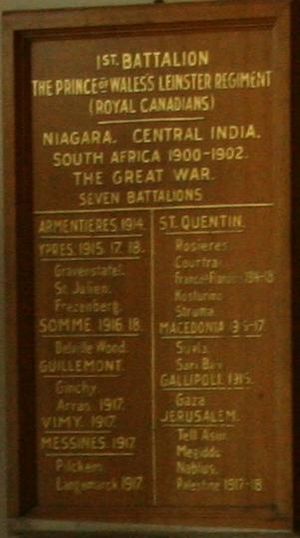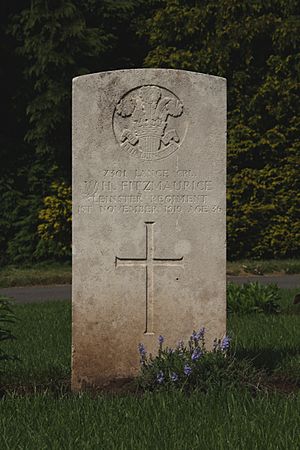Prince of Wales's Leinster Regiment (Royal Canadians) facts for kids
Quick facts for kids Prince of Wales's Leinster Regiment |
|
|---|---|

Badge of the Prince of Wales's Leinster Regiment
|
|
| Active | 1881–1922 |
| Allegiance | |
| Branch | |
| Type | Infantry Regiment |
| Role | Line Infantry |
| Size | 2 Regular Battalions 3 Militia and Special Reserve Battalions |
| Garrison/HQ | Birr Barracks, Birr |
| Nickname(s) | Royal Canadians |
| Patron | Prince of Wales |
| Motto(s) | Ich Dien (I Serve) |
| March | Quick: The Royal Canadian; Come Back to Erin |
The Prince of Wales's Leinster Regiment (Royal Canadians) was a special group of soldiers, called an infantry regiment, in the British Army. It was created in 1881 by joining two older regiments: the 100th (Prince of Wales's Royal Canadian) Regiment of Foot and the 109th Regiment of Foot (Bombay Infantry). The 100th Foot started in 1858, and the 109th in 1853.
This regiment was one of eight "Irish regiments" that mostly recruited soldiers from Ireland. Their main base, called a home depot, was at Birr Barracks in Birr. The regiment was closed down in 1922 when Ireland became independent. This happened because their recruiting areas were now part of the new country.
Contents
What is the History of the Leinster Regiment?
How the Regiment Began in the 1800s

The Prince of Wales's Leinster Regiment was formed in 1881. This was part of a big plan by the British government to reorganize the British Army. This plan was known as the Childers Reforms.
This regiment was one of eight special "Irish regiments" in the British Army. Most of its soldiers came from Ireland, especially from the province of Leinster. Their main base was in Birr. At that time, all of Ireland was managed as a separate military area.
The 1st Battalion of the regiment moved from India to Ireland in 1894. Some of its soldiers fought in the Fourth Anglo-Ashanti War in 1895. Later, in 1898, they moved to Halifax, Canada. The 2nd Battalion moved to Ireland in 1882, then to England in 1888. They later served in Malta, Bermuda, and the West Indies.
Fighting in the Second Boer War
Both the 1st and 2nd Battalions went to South Africa to fight in the Second Boer War. The 1st Battalion was involved in battles near Bethlehem in April 1902. The 2nd Battalion helped protect a railway line in February 1902.
A third group, called the 3rd Militia Battalion, also joined the war in South Africa in 1900. They returned to Ireland in May 1902. In 1908, the army changed how it organized its reserve forces. The regiment then had three reserve battalions.
Serving in the First World War
During the First World War, many soldiers from the Leinster Regiment fought.
Regular Army Battalions
The 1st Battalion, which was in India, arrived in France in December 1914. They fought on the Western Front. Later, they moved to Salonika in December 1915. In September 1917, they went to Egypt to serve in Palestine.
The 2nd Battalion arrived in France in September 1914. They also served on the Western Front throughout the war.
New Army Battalions
The 6th (Service) Battalion landed at Anzac Cove in August 1915. They then moved to Salonika in September 1915. After that, they went to Egypt for service in Palestine in September 1917. Finally, they arrived in France in June 1918 to fight on the Western Front.
The 7th Battalion landed in France in December 1915. They also served on the Western Front.
Why Was the Regiment Disbanded?

In 1922, there were big cuts to military spending. Also, the Irish Free State became an independent country. Because of these changes, six Irish regiments, including the Prince of Wales's Leinster Regiment, were closed down.
On June 12, 1922, the flags of five regiments were placed in a special ceremony at Windsor Castle. All six regiments were officially disbanded on July 31, 1922. Many former soldiers and officers from these regiments joined the new National Army of the Irish Free State. They brought valuable fighting experience with them. Soldiers who wanted to stay in the British Army could transfer to other units.
The officers of the 1st Battalion gave their special silverware, known as "The Leinster Plate," to the Government of Canada. This was a way to honor their Canadian connection. The silver is now kept at the Royal Military College of Canada.
In 2013, a memorial was built in Birr to remember the regiment's strong ties to the area and Birr Barracks.
What Were Their Battle Honours?
Battle honours are special awards given to military units for their bravery and success in battles. The Leinster Regiment earned many battle honours throughout its history. Some of these include:
- From the 100th Regiment of Foot: Niagara
- From the 109th Regiment of Foot: Central India
- Second Boer War: South Africa 1900–02
- The Great War:
- Armentières 1914
- Second Battle of Ypres (including battles like Gravenstafel, St. Julien, and Frezenberg)
- Battle of the Somme (including battles like Bourlon Wood, Guillemont, and Ginchy)
- Battle of Arras (including Vimy Ridge)
- Third Battle of Ypres (including battles like Messines, Pilckem Ridge, Battle of Langemarck (1917), First Passchendaele, and Second Passchendaele)
- The German Offensives 1918 (including battles like First Battles of the Somme, 1918, St. Quentin, Actions at the Somme Crossings, and Rosieres)
- Courtrai 1918
- The Advance To Victory 1918 (including battles like Amiens, Delville Wood, and Cambrai, 1918)
- Macedonia 1915–17 (including battles like Kastrino and Struma)
- Gallipoli 1915 (including battles like Suvla and Sari Bair)
- Palestine 1917–18 (including battles like First Gaza, Jerusalem (1917), Megiddo, Nablus, and Tell 'Asur)
Who Received the Victoria Cross?
The Victoria Cross is the highest award for bravery in the British military. Several members of the Leinster Regiment received this honor during the Great War:
- Lieutenant John Vincent Holland
- Corporal John Cunningham
- Private Martin Joseph Moffat
- Sergeant John O'Neill
Images for kids





